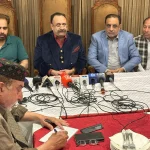This year, to date, Indian security forces have killed upward to 31 Kashmiri youngsters and 63 rebels, while hundreds more were critically injured.
Most of protesting civilians were directly fired upon, above waist level, after they came out on to the streets to pelt stones and help rebel fighters sneak past military cordons.
More and more young men and women are showing up at gunfight sites, especially in the southern areas of Indian-occupied Kashmir. Previously, in the 1990s when armed rebellion against Indian rule was at its peak, people would stay ensconced inside their homes to avoid encounters between rebel fighters and the Indian security agencies.
But this equation has now changed, more so after the rise and fall of a charismatic commander, Burhan Muzaffar Wani, 22, killed by uniformed men in 2016. Youngsters are now taking to the streets to rescue trapped rebel fighters.
Meanwhile, India’s Army Chief General Bipin Rawat continues to issue provocative statements. In February 2017, he publicly issued a warning: if youth who pelt stones at forces continue to disrupt counter insurgency operations then these young men and women will be termed as “over the ground workers of terrorists” and the army “will not spare them”. On May 10, in an interview to The Indian Express, the general said, “I want to tell Kashmiri youth that Azadi (freedom) isn’t possible. It won’t happen. Don’t get carried away unnecessarily. Why are you picking up weapons? We will always fight those who seek Azadi, those who want to secede. Azadi is not going to happen, never.”
Support for armed rebellion
The support for rebel groups comes from the fact that most of the population remains sympathetic towards the idea of Azaadi. Funerals of homebound rebels get a groundswell of support.
In October 2015, when Abu Qasim, a Pakistan-origin rebel fighter who fought for more than five years in Indian-occupied Kashmir, was killed, a sea of people turned up for his burial. The immense gathering surprised the entire security grid.
This trend took new form when Wani was killed in July 2016. His funeral triggering a major debate in Kashmir about whether the India government should consider the participation of such a huge number of people as a “political referendum” of sorts.
For several years now, the state police insists that the number of rebel fighters is close to 300. But, after the death of Wani, and subsequent launch of a counter-insurgency operation by Indian forces, more than 250 youngsters are unofficially estimated to have joined armed ranks.
For guerrilla-warfare to thrive in a heavily militarised zone, it needs the support of the populace. Therefore, the Kashmir’s armed rebellion, which uses limited violence, has every possibility to survive until a political solution is reached.
Anywhere between 600,000 to 750,000 troops are deployed in Indian-occupied Kashmir. Do you need that many men, with sophisticated arms and ammunition, to fight only 300 rebels? Going by this logic, killing such a small pack of rebels shouldn’t be a problem. So then what is causing the failure?
The blow back
Last year, the Indian establishment promised to flush out the idea of militancy through Operation All-Out. Senior police officials in Kashmir were boasting that it was only a matter of time when militancy would be eliminated from the region. But this year, it is again embroiled in trying to quell an insurgency.
At the state level, the coalition administration remains helpless. Its futility was exposed post the Kathua rape, where an 8-year-old Muslim girl was abducted, raped and killed by Hindu men. Since then, the Peoples Democratic Party and the Bharatiya Janata Party seem to be at loggerheads.
India’s carrot-and-stick approach, that has been the benchmark of its Kashmir policy, will continue to give impetus to scholars – such as Mannan Wani of the Aligarh Muslim University and Mohammad Rafi from the Kashmir University – as well as youths, to take up arms and to speak to the state in its own language.








